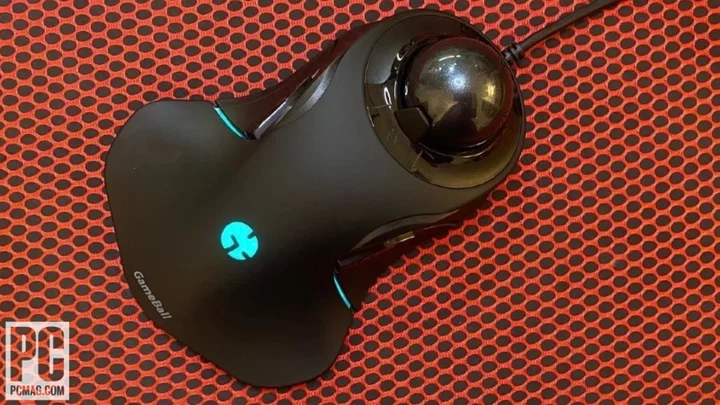If you’re on the hunt for a new gaming mouse, chances are a trackball isn’t on your list. That's partly because there just aren’t that many dedicated gaming trackballs, and partly because trackballs are really only usable in certain game genres and situations, like open-world games where you have to pan across large areas quickly. One of your few options is the plainly named GameBall ($148), the world’s first (according to its designer) trackball specifically made for gaming on PCs. With an ambidextrous design and a capable, accurate sensor, the GameBall is a competent peripheral, though it lacks configuration software for customization, and most of its innovation is middling at best. It’s a decent option if you’re looking for specialized peripherals that go easy on your wrists, but you must be willing to deal with more than a few idiosyncrasies and an unforgiving price.
Design: Roll On, Don't Slide Over
The GameBall’s shape is not unlike a conventional mouse, with a long and wide body to support your hands and wrists. A small LED shines a ray of light through a GameBall logo, the only design flourish on the mouse's otherwise all-black body. It measures 6.4 by 4.7 by 2 inches (HWD) and weighs 8.1 ounces, almost double the weight of the Kensington Pro Fit Ergo TB550, though added weight is typically welcome for gaming mice.
The 1.5-inch trackball itself sits at the top end of the mouse, easily accessible to your fingertips. You'll find three buttons to the left of the trackball, and three buttons to the right. Two of each set are for left and right clicks, while the third button on the left side is for center clicks, and the third button on the right side controls the mouse's dots per inch (DPI) setting.
(Credit: Zackery Cuevas)In lieu of a scroll wheel, the GameBall uses a touch surface that surrounds the trackball. Sliding a finger down the right side controls the vertical scroll, while the left controls the horizontal scroll. It's a cool feature, but the touch panel is nowhere near as accurate as we’d like it to be, and is no replacement for a traditional scroll wheel. Oftentimes in testing I’d scroll too far or too slowly, and I never felt like I had full control over my movements.
The trackball itself proved to be far more accurate, but not without its own idiosyncrasies. It employs an unspecified PixArt sensor that allows for a maximum 3,000dpi tracking resolution and a polling rate of 1,000Hz. The mouse comes equipped with five presets: 400dpi, 800dpi, 1,200dpi, 2,000dpi, and 3,000dpi. Switching among them isn’t as simple as you’d imagine, though. Typically, a gaming mouse will have a DPI button that toggles among presets. That’s true here, but instead of pressing the DPI button to the right of the trackball, you hold it down and watch the LED flicker; the number of blinks indicates which DPI setting you’re on. For example, one blink means you're on the 400dpi setting, two means you're on 800dpi, and so on.
While it’s certainly a different way of doing things, it’s clumsy and by no means an improvement on the traditional DPI-switch design. The 3,000dpi maximum setting might also be a point of contention for some gamers. Many of today's gaming mice can crawl as high as 30,000dpi (see the Razer DeathAdder V3 Pro). Even the budget-priced HyperX Pulsefire Haste 2 reaches a maximum of 26,000dpi.
(Credit: Zackery Cuevas)Testing the GameBall: Comfortable But Limited
However, the low DPI ceiling may not be as much of an issue as it would otherwise seem, thanks to the design of the trackball itself. Typical mice rely on full wrist movement, while the trackball eliminates the need for hand and wrist movement entirely. As such, using your fingers to navigate a 3,000dpi trackball is no more unwieldy (or no less manageable, depending on the kind of gamer you are) as navigating other gaming mice with higher DPIs.
(Credit: Zackery Cuevas)The benefits of trackballs are easy to see, and probably easier to feel. Long-term use can potentially stymie unwanted strain and other complications with your hands and wrists. But making the switch from conventional mouse to trackball will be a bit of a learning curve if it’s your first time. After spending a few weeks with the GameBall, I felt comfortable in my movements, even if the scrolling and DPI switching were more cumbersome than I would’ve liked, and the lack of customization software meant I could not tweak many of the settings to my liking. The 1,200dpi setting felt a little too fast, 800dpi felt a bit too slow, and with no way to find a middle ground, I mostly just found myself yearning for another mouse.
Overall, for almost $150, this gaming mouse is somewhat frustrating to take into battle. I definitely could see how some folks would think of it as more precise in a certain subset of games, but it just didn’t work as well as I wanted it to. For scrolling through simple applications or general internet browsing, it works fine, but plenty of other trackball mice do that too, for about half the price.
Verdict: Better Scrolling Next Time
The GameBall is an interesting, if not-quite fully baked, first try at a gaming trackball for those looking for a different spin on an ergonomic mouse. We could see it working well for people who are differently abled, as well as for those just looking to do some light gaming that isn't impacted by low DPI settings or a lack of customization options.
(Credit: Zackery Cuevas)Still, the GameBall just has too steep of a learning curve and too high of a price relative to its features to warrant a full recommendation. It's really only suited to people who actually need an ergonomic alternative to a traditional mouse. And even then, it's not a slam dunk. You might be better served instead by the Microsoft Adaptive Mouse and its modular design, which offers more features and customization than the GameBall for less money.









